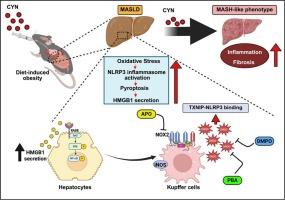Peroxynitrite is key to Cylindrospermopsin-mediated MASLD to MASH progression via triggering TXNIP binding to NLRP3 and subsequent inflammasome activation
IF 3.4
3区 医学
Q2 PHARMACOLOGY & PHARMACY
引用次数: 0
Abstract
Harmful algal bloom (HAB) toxins are shown to be associated with Metabolic dysfunction-associated steatohepatitis (MASH) progression. Several studies link the HAB toxin microcystin to hepatic inflammasome activation, but the role of cylindrospermopsin (CYN) in Metabolic dysfunction-associated steatotic liver disease (MASLD) pathology remains unknown. Using a mouse model of MASLD, we show that CYN exposure served as a second hit for MASLD to MASH progression, as shown by histopathology and NAS scoring. The pathology was attenuated by the use of NADPH oxidase 2 (NOX2) inhibitor apocynin and peroxynitrite inhibitor phenylboronic acid. Inhibition of peroxynitrite and other redox signaling processes decreased stellate cell activation and fibronectin protein in the hepatic lobules, thus confirming the involvement of the above nitrosative moiety in early fibrotic remodeling, crucial for MASH progression. Redox inhibitors also decreased the endothelial Nitric Oxide Synthase (eNOS)/inducible Nitric Oxide Synthase (iNOS) protein ratio, thus raising the yield of inducible nitric oxide and facilitating the uncoupling of eNOS. Mechanistically, peroxynitrite inhibitors coupled with attenuation of redox processes prevented Thioredoxin-interacting protein (TXNIP) colocalization with NLRP3 and resulted in the inhibition of NLRP3 inflammasome activation, a crucial mediator of hepatic inflammation in MASH. Hepatocyte-hepatic macrophage crosstalk, crucial for MASH progression, was shown to induce NOX2 activation, the generation of 3-nitrotyrosine in close proximity to iNOS, a predictive nitric oxide source, thus confirming the role of these cells in activating the inflammation cascade. The results show a crucial role of peroxynitrite in TXNIP-NLRP3 induced inflammasome activation and can be a crucial therapeutic target in treating MASH etiology from environmental exposure.

过氧亚硝酸盐通过触发TXNIP结合NLRP3和随后的炎性体激活,是柱精子素介导的MASLD的关键
有害藻华(HAB)毒素被证明与代谢功能障碍相关的脂肪性肝炎(MASH)进展有关。一些研究将HAB毒素微囊藻毒素与肝炎性体激活联系起来,但柱精子素(CYN)在代谢功能障碍相关脂肪变性肝病(MASLD)病理中的作用尚不清楚。使用小鼠MASLD模型,我们发现CYN暴露是MASLD向MASH进展的第二个打击,如组织病理学和NAS评分所示。NADPH氧化酶2 (NOX2)抑制剂罗布麻碱和过氧亚硝酸盐抑制剂苯硼酸可减轻病理。过氧亚硝酸盐和其他氧化还原信号过程的抑制降低了肝小叶中的星状细胞活化和纤维连接蛋白,从而证实了上述亚硝化部分参与早期纤维化重塑,对MASH进展至关重要。氧化还原抑制剂还降低了内皮型一氧化氮合酶(eNOS)/诱导型一氧化氮合酶(iNOS)蛋白的比例,从而提高了诱导型一氧化氮的产率,促进了eNOS的解偶联。机制上,过氧亚硝酸盐抑制剂与氧化还原过程的减弱相结合,阻止了硫氧还蛋白相互作用蛋白(TXNIP)与NLRP3共定位,并导致NLRP3炎症小体激活受到抑制,而NLRP3炎症小体是MASH中肝脏炎症的重要介质。肝细胞-肝巨噬细胞串扰对MASH进展至关重要,可诱导NOX2激活,在iNOS附近产生3-硝基酪氨酸,这是一种可预测的一氧化氮来源,从而证实了这些细胞在激活炎症级联反应中的作用。结果表明,过氧亚硝酸盐在TXNIP-NLRP3诱导的炎症小体激活中起着至关重要的作用,可能是治疗环境暴露引起的MASH病因的关键治疗靶点。
本文章由计算机程序翻译,如有差异,请以英文原文为准。
求助全文
约1分钟内获得全文
求助全文
来源期刊
CiteScore
6.80
自引率
2.60%
发文量
309
审稿时长
32 days
期刊介绍:
Toxicology and Applied Pharmacology publishes original scientific research of relevance to animals or humans pertaining to the action of chemicals, drugs, or chemically-defined natural products.
Regular articles address mechanistic approaches to physiological, pharmacologic, biochemical, cellular, or molecular understanding of toxicologic/pathologic lesions and to methods used to describe these responses. Safety Science articles address outstanding state-of-the-art preclinical and human translational characterization of drug and chemical safety employing cutting-edge science. Highly significant Regulatory Safety Science articles will also be considered in this category. Papers concerned with alternatives to the use of experimental animals are encouraged.
Short articles report on high impact studies of broad interest to readers of TAAP that would benefit from rapid publication. These articles should contain no more than a combined total of four figures and tables. Authors should include in their cover letter the justification for consideration of their manuscript as a short article.

 求助内容:
求助内容: 应助结果提醒方式:
应助结果提醒方式:


